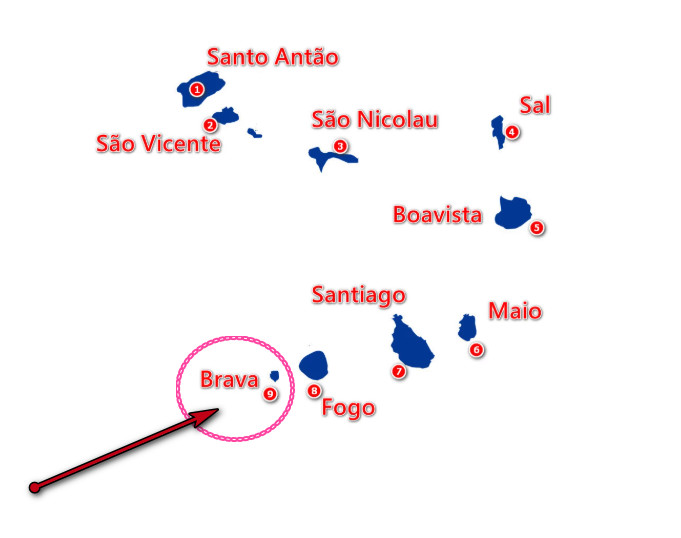Cabo Verde - Brava island
Brava: The Island of Flowers and Volcanic Peaks

Welcome to Brava, the smallest inhabited gem in the Cabo Verde archipelago—a hidden paradise often called the "Island of Flowers" or "Garden Island". If you're craving peace, jaw-dropping hikes through misty mountains, and a landscape bursting with color, this is your escape. Forget crowded beaches and tourist traps. Brava rewards the curious traveler with raw, untamed beauty, cool breezes, and trails that wind through clouds and wildflowers. At just 62.5 km²—roughly 10.5 km long and 9.3 km wide—this compact volcanic wonder feels like a secret garden floating in the Atlantic.
Where Brava Hides in the Atlantic
Tucked in the extreme southwest of Cabo Verde, Brava belongs to the Sotavento (Leeward) Islands. It sits just 18–20 km west of Fogo, its fiery big sister, and the two are linked deep beneath the ocean by a shared volcanic ridge. The name "Brava" means "wild" in Portuguese—and one look at its jagged cliffs and cloud-wrapped peaks tells you why.
A Volcano in Disguise: The Island's Dramatic Backbone
Don't let the greenery fool you—Brava is a stratovolcano in hibernation. Nearly the entire island is built from ancient lava flows and ash, making it one of the younger islands in the chain. At its heart lies a massive central caldera, formed around 400,000 years ago. The charming capital, Nova Sintra, nestles inside a lush depression called Fundo Grande—thought to be a half-buried crater or secondary caldera.
Though Brava has no recorded eruptions in human history, it's far from asleep. Small earthquakes rumble regularly, a gentle reminder that the magma chamber below is still alive. The terrain is rugged and relentless: an irregular high plateau between 300 and 976 meters, carved by deep gorges, dramatic valleys, and knife-edge ridges. The island's highest point, Monte Fontainhas (976 m), pierces the clouds like a green spear.
Along the coast, sheer cliffs plunge straight into the sea—no gentle slopes here. This vertical geography is what makes Brava a hiker's dream and a beachgoer's rethink.
The Green Miracle: Why Brava Blooms
Brava is the greenest island in Cabo Verde, a lush anomaly in an arid archipelago. The secret? Geography and Fogo's shadow.
Sitting in the lee of Fogo's massive volcano, Brava catches clouds that would otherwise drift past. As trade winds slam into Fogo, they rise, cool, and spill over to Brava as mist and fog. These clouds cling to Monte Fontainhas, feeding natural springs and painting the highlands in emerald.
The result? A plant explosion. Wander the trails and you'll pass:
- Vibrant hibiscus and wildflowers in every color
- Towering eucalyptus and pine
- Fruit-laden mango, papaya, and guava trees
- The rare Dragon Blood Tree (Dracaena draco), with its umbrella canopy—spot them in Nova Sintra and Cova Rodela
Thanks to elevation, Brava has multiple microclimates. Coastal villages bake in warm, dry air, while the interior stays cool and temperate. In Nova Sintra, expect 18–28°C year-round, with the greenest, most floral season from October to February—perfect for hiking without melting.
The Coastline of Brava: Where the Mountains Meet the Sea
Brava isn't a beach island—but its coastline is stunningly dramatic. Steep cliffs give way to hidden coves, natural pools, and one surprising stretch of sand.
Fajã d'Água: The Postcard Village
This emerald valley village is a must-visit. Tucked at the foot of the mountains, it opens to one of Cabo Verde's most beautiful bays. Hike down from the highlands, and your reward? Crystal-clear natural pools carved from black volcanic rock—turquoise water, safe swimming, zero crowds. Pure magic.
Furna: The Island's Front Door
The main port sits in a crescent-shaped bay—an ancient volcanic crater turned harbor. Fishing boats bob against a backdrop of cliffs. This is where you'll arrive by ferry from Fogo.
Porteto: Brava's Only Beach
Near the abandoned Esperadinha Airport, you'll find the island's only black sand beach. It's small, wild, and framed by lava rock—perfect for a quiet dip or sunset photos.
VIDEO: The traveler explores Brava, Cape Verde's southernmost island. In Fajã d'Água, he marvels at stunning natural pools despite cool weather. The tiny village offers peace and isolation. Using public transport, he visits Nova Sintra, the clean, green capital known as the "Island of Flowers." He praises fertile soil, painted houses, and relaxed vibe. He ends by explaining Cape Verde's division: Sotavento (south, wind-sheltered) and Barlavento (north)
Hiking Heaven: Trails Through Clouds and Flowers
Brava's geography was made for trekking. Steep paths connect hilltop villages, skirt crater rims, and plunge to the coast. Every turn reveals panoramic views—green peaks, drifting clouds, and the endless Atlantic.
Top trails for visitors:
- Nova Sintra to Nossa Senhora do Monte: A scenic ridge walk through pine forests and flower fields
- Highlands to Fajã d'Água: A rewarding descent from cloud level to natural pools
- Cova Rodela crater loop: Explore a sunken volcanic bowl surrounded by dragon trees
Pro tip: Trails are steep and unmarked in places—hire a local guide in Nova Sintra. They know the weather, the shortcuts, and the best spots for coffee with a view.
Final Takeaway: Brava in a Nutshell
Feature Details
Size 62.5 km² – smallest inhabited island
Highest Point Monte Fontainhas, 976 m
Volcanic Status Dormant stratovolcano, seismically active
Green Season October–February (coolest, most floral)
Best For Hiking, nature, tranquility, wild swimming
Don't Expect Long sandy beaches, nightlife, crowds
Brava isn't for everyone—and that's exactly why it's perfect. If you want an island where flowers grow on volcanoes, where clouds are your hiking companions, and where every path feels like a discovery, pack your boots and come. This wild, blooming volcano is waiting.
